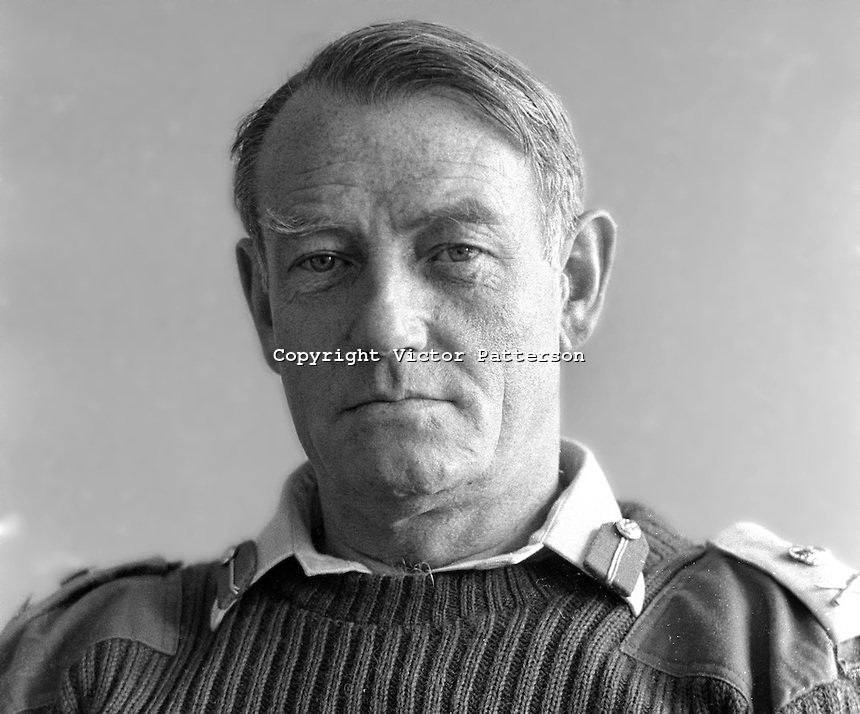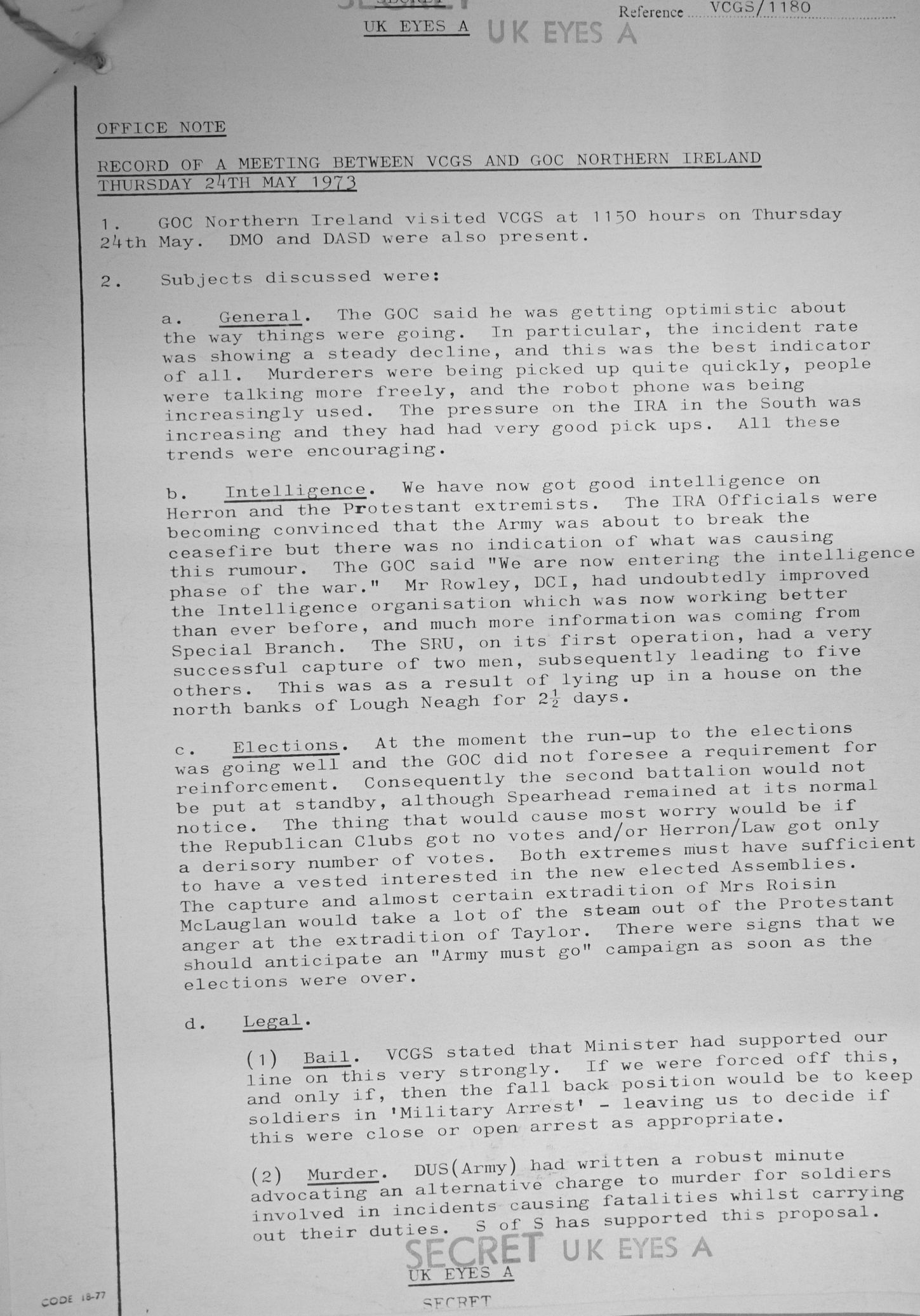- Did The British Army Have A High-Level IRA Agent In 1973 Code-Named ‘Brocolli’?
That is the intriguing question that jumps out of the pages of a de-classified British military document recently released by the British National Archives at Kew.
The document carries an account of a meeting in May 1973 between two of the most senior British Army officers involved in the conflict in Northern Ireland during which the existence of a source, apparently named ‘Brocolli’, is mentioned, along with “the problem” of the source’s protection.
One was the GOC, or General Officer Commanding British troops, Sir Frank King who served in that post between February 1973 and August 1975; the other was the Vice Chief of the General Staff, the second most senior officer in the British Army, Sir David Fraser, who was a veteran of the British Army’s campaigns in Malaya, Cyprus and Suez. He went on to be the UK Military Representative at NATO.
 |
| General Sir Frank King, British GOC in Northern Ireland in 1973 |
 |
| Add caption |
The source “Brocolli” was brought up at the very end of their meeting, the last of eight topics discussed and is accorded a short, terse sentence that reads:
h. Brocolli. VCGS brought the GOC up to date and discussed the problem of protection of the source.
There is no clue about “Brocolli’s” identity, not even that it is a person rather than a thing, and nor is it at all clear whether “Brocolli” is associated with Republican paramilitaries rather than Loyalists. However the paper makes an earlier reference to the fact that the Army now has “good intelligence” on the UDA and the absence of a reference to “Brocolli” at this point in the discussion suggests it was not a Loyalist source. That points to a Republican connection and, since the Provisional IRA was the British Army’s principal foe in 1973, that “Brocolli” was somehow associated with that camp.
What is beyond dispute is that “Brocolli” was a very important source. Otherwise he, she or it would hardly rank as a subject for discussion between two such senior military figures. The fact that “Brocolli” is clearly in need of protection also points to a human source rather than an insentient entity, such as a bugging device. Had “Brocolli” been an Operation then it would have been written as “Operation Brocolli”, in accordance with British military practice.
The intelligence war merits one of the longest paragraphs in the document and the discussion is notable for King’s declaration: “We are now entering the intelligence phase of the war”. The recent creation of the Director and Co-ordinator of Intelligence (DCI), which was a joint MI5/MI6 body created in 1972, is credited for improving the flow of information as was a much improved RUC Special Branch. The DCI was traditionally headed by an MI5 officer who, in 1973, was a “Mr Rowley”.*
Mention is also made of the SRU, or Special Reconnaissance Unit, a successor to the MRF (Military Reaction Force) and forerunner of the FRU (Force Research Unit). In 1973, the SRU operated under the cover name of NITAT(NI) – a forerunner of the 14th Intelligence Company, known as “the Det” in military circles.
The paragraph reads (our comments in parenthesis):
We have now got good intelligence on Herron (Tommy Herron, then leader of the UDA) and the Protestant extremists. The IRA Officials were becoming convinced that the Army was about to break the ceasefire but there was no indication of what was causing this rumour. The GOC said ”We are now entering the intelligence phase of the war”. Mr Rowley, DCI, had undoubtedly improved the Intelligence organisation which was now working better than ever before, and much more information was coming from Special Branch. The SRU, on its first operation, had a very successful capture of two men, subsequently leading to five others. This was as a result of lying up in a house on the north banks of Lough Neagh for 2 1/2 days.
Sir David Fraser’s satisfaction at the progress made in the intelligence war with the IRA seems to have been justified. Less than two months after their meeting, the British Army’s top brass were celebrating the arrests of Gerry Adams, Brendan Hughes, Tom Cahill and other senior members of the IRA in Belfast as a result of intelligence allegedly provided by the IRA’s then Belfast Quarter-Master, Eamon Molloy, a double agent who was later killed and his body ‘disappeared’ by the IRA.
However Molloy was recruited by the RUC Special Branch, not the British Army, during interrogation at Castlereagh Holding Centre so he is unlikely to have been “Brocolli”.
Another candidate for “Brocolli” was Freddie Scappaticci, a senior member of the IRA’s Internal Security Unit – the IRA’s spycatchers. He was interned at Long Kesh at the time, as another military document released by Kew reveals, and therefore could not have been the source discussed by Fraser and King. Scappaticci was later recruited and subsequently managed by the FRU and, according to some former FRU members, given the codename ‘Steaknife’.
Scappaticci was listed among a number of IRA internees whose names had been submitted by the then SDLP leader Gerry Fitt to British Secretary of State William Whitelaw, in July 1973 for release.
The documents reveal that internees could apply for release if they agreed to sign an oath saying that they had ‘recanted’ their support for the IRA (a similar arrangement existed during the 1956-62 IRA campaign). Fitt’s list includes 33 men, sixteen of whom, including Scappaticci, “have recanted but will not sign an oath”. That list also included Kevin Hannaway, who went on to become the IRA’s Adjutant-General in the 1980’s. His presence on the list along with eight former ‘OC’s’, or Officers Commanding, seems to justify British Army scepticism at the tactic, as one senior officer commented:
Attached to this minute at Annex A is a list of the 30 men who Mr Fitt is attempting to get released from internment. All of them are known hard men, some harder than others. But Mr Whitelaw has been told that of the 86 men released from Long Kesh in the last six months 57 are known to have returned to terrorism almost immediately. Therefore although everything possible should be done to keep the SDLP on the right side of the Executive bargaining, Mr Fitt’s request should not be given in to too easily.
 |
Was ‘Brocolli’ a human agent buried inside a paramilitary group, the IRA for instance. Or was it something else?
 |
Gerry Fitt’s list of requested releases from Long Kesh included Freddie Scappaticci, later the alleged agent ‘Steaknife’. |
* Thanks to Tom Griffin who tweeted that Rowley was more likely to have been MI6 than MI5. See this link.



What with Stakeknife and now this....this is turning in to a Sunday lunch!!!!!
ReplyDelete